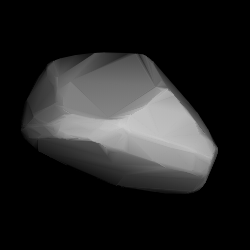 Shape model of Borodino from its lightcurve | |
| Discovery [1] | |
|---|---|
| Discovered by | N. Chernykh |
| Discovery site | Crimean Astrophysical Obs. |
| Discovery date | 7 September 1977 |
| Designations | |
| (3544) Borodino | |
Named after | Borodino (village) (Battle of Borodino) |
| 1977 RD4 ·1936 QJ1 1943 GM ·1947 LO 1951 RW1 ·1951 SJ 1980 FM11 ·1981 RN5 | |
| main-belt [1] [2] ·(inner) [3] background [4] | |
| Orbital characteristics [2] | |
| Epoch 23 March 2018 (JD 2458200.5) | |
| Uncertainty parameter 0 | |
| Observation arc | 75.06 yr (27,414 d) |
| Aphelion | 2.9302 AU |
| Perihelion | 1.8718 AU |
| 2.4010 AU | |
| Eccentricity | 0.2204 |
| 3.72 yr (1,359 d) | |
| 344.02° | |
| 0° 15m 53.64s / day | |
| Inclination | 8.9017° |
| 147.61° | |
| 148.82° | |
| Physical characteristics | |
| 6.11±0.55 km [5] 8.502±0.075 km [6] 8.688±0.056 km [7] | |
| 5.435±0.00005 h [8] 5.437±0.001 h [9] 5.44±0.01 h [10] 5.442±0.002 h [a] | |
Pole ecliptic latitude | |
| 0.2361±0.0290 [7] 0.247±0.027 [12] 0.474±0.088 [5] | |
| S (assumed) [3] | |
| 12.4 [2] [3] 12.50 [5] [7] | |
3544 Borodino (prov. designation: 1977 RD4) is a stony background asteroid from the inner regions of the asteroid belt, approximately 9 kilometers (5.6 miles) in diameter. It was discovered on 7 September 1977, by Soviet astronomer Nikolai Chernykh at the Crimean Astrophysical Observatory in Nauchnij, on the Crimean peninsula. [1] The likely elongated S-type asteroid has a rotation period of 5.44 hours. [3] It was named for the Russian village of Borodino where the Battle of Borodino took place. [1]